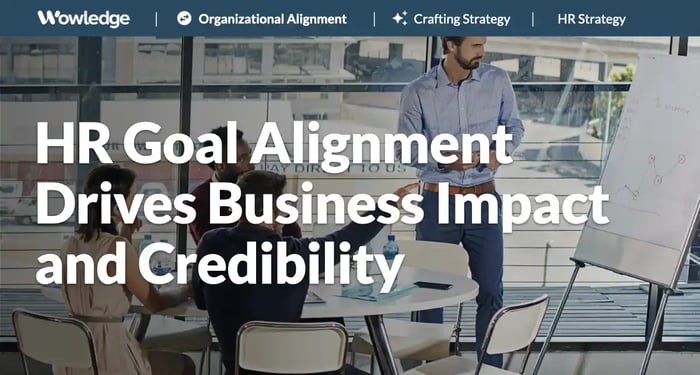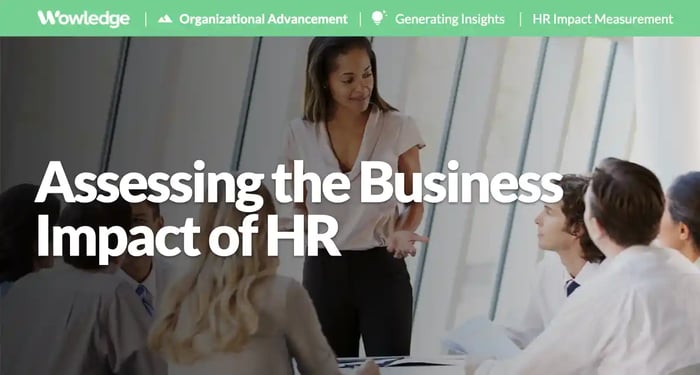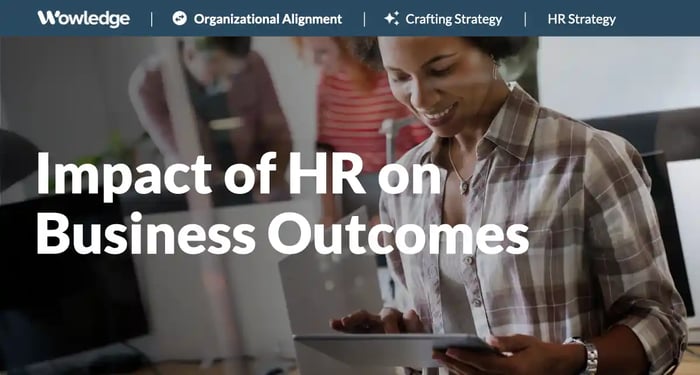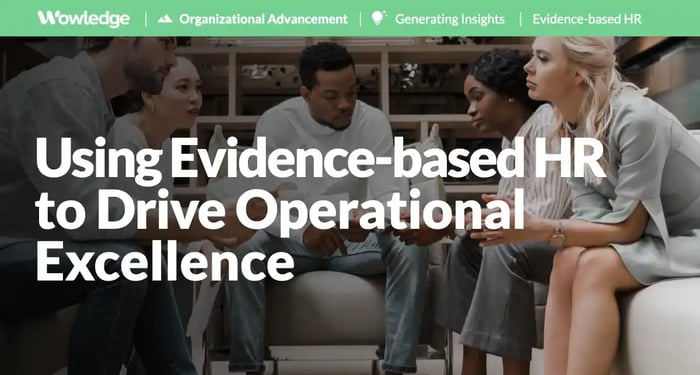Table of Contents
- The disconnect between aligning HR goals and business objectives is real
- And yet... the impact of HR goal alignment is clear
- Types of HR goals
- The benefits of HR goal alignment
- Key steps to translate business goals into HR strategies and objectives
- Critical considerations for HR goal alignment
- Relevant Practices & Tools
- About Wowledge
So much has been written over the years about HR becoming a better business partner, getting a seat at the table, and aligning its efforts (processes, programs, policies, platforms, and practices) with business needs, and yet this continues to be a struggle for many HR leaders and professionals. In reality, while most all understand that “doing HR for HR’s sake” does not serve its reason for existence, ensuring HR goal alignment with the business is a core element of making those a reality. Sadly, making it happen continues to vex many HR leaders.
A recent HR expert's comment to a Wowledge LinkedIn post about “reverse engineering” business goals to HR priorities throughout his career was striking and inspired this post. Years of experience helping organizations align HR goals with business objectives came back to mind, along with a reminder of the lack of understanding—even among leading organizations—on how to accomplish this critical task. The challenges organizations of all sizes and scales continue to exist and limit the potential impact of their myriad efforts to support business direction. But how common is it as an issue?
The disconnect between aligning HR goals and business objectives is real
Research finds that HR goal alignment is lacking in most organizations. For example, one study found that over 50% of organizations' HR services and programs are not connected to a specific business purpose. Less than 15% of HR teams can articulate how their policies, practices, or programs are designed to impact business goals. The risk is that those functions operate much of what HR requires for some assumed and unclear business purpose and value.
Furthermore, LinkedIn found that only 9% of companies understand which talent dimensions drive organizational performance, meaning that the programs and policies they designed have an uncertain basis and linkage to achieving corporate objectives. Interestingly, the alignment between HR strategy and business goals has ranked near the bottom of HR priorities, most recently by HR leaders. This points to a lack of understanding of the value of business-aligned HR goals in establishing and maintaining the function’s importance and relevance to the company.
And yet... the impact of HR goal alignment is clear
An abundance of data has proven that a high level of HR goal alignment is associated with substantially higher business outcomes. It has been demonstrated that HR efforts to drive and improve employee engagement, talent development and allocation, employee experience, advanced HR practices, culture, and leadership effectiveness have a pronounced impact on company outcomes. They significantly impact revenue, profitability, quality, customer satisfaction and loyalty, market capitalization, and total return to shareholders.
The value that HR goal alignment brings to the perceived value of the function is also at stake. A common theme is that many leaders and managers have a modest, if not negative, view of HR as a valued business partner. This is primarily due to a lack of clearly understood alignment of HR practices, policies, and programs to the business. For example, a recent industry study found that (despite the evidence of HR impact above) only 27% of executives understand that HR impacts revenue growth, customer satisfaction (30%), cost savings (27%), and product or service quality (28%). Perhaps worse is the finding that only 53% of HR leaders believe their efforts had a business impact.

Types of HR goals
Not all HR goals and objectives are the same, and understanding how their applications differ is an essential starting point for every CHRO, CPO, HRBP, and COE or HRSS leader. Both types focus on establishing targets and action plans, specifically in service or supporting a related business objective or initiative. HR goal alignment is enhanced when used in both circumstances.
Strategic business transformation and growth objectives
These are long-term (annual or multi-year), developmental targets designed to build or enhance enterprise-level capabilities. They are often tied to corporate growth and market-shifting aspirations related to a renewed customer focus, product or service introduction, quality enhancement, or market expansions. These lend themselves to longer-term HR and talent solutions that involve multiple HR and other functional (e.g., IT, finance) specialists and address challenges such as upskilling all programmers, developing more AI readiness across functions or business units, developing new sources for needed talent, or transforming the compensation strategy.
Short-term and responsive operational goals
They address more minor but significant challenges that arise or inhibit the ongoing operations or pathway to larger strategic objectives. These tend to be characterized by their shorter-term nature and are targeted at solving issues or improvements in business units, functions, facilities, or working groups. These are designed on a smaller scale, often by local or specialized (e.g., COE) HR resources, and can be business (e.g., work process redesign) or specified HR (e.g., team building, special project chartering) solutions.
The benefits of HR goal alignment
Aligning HR goals to business objectives communicates a clear and consistent business purpose for every HR initiative, practice, policy, or program. It establishes a value proposition in end-users' minds who often ask “why” they need to participate in and complete what can be (fairly or otherwise) a bureaucratic endeavor. It also allows business and HR leaders to explore the continuing value and necessity of the process or practice. Aside from those, by focusing on strategic alignment, HR management can effectively contribute to the long-term success of the enterprise in several ways, including:
- Establishing a solid HR investment rationale. The more precise HR goals are aligned with the business, the more easily any required financial or effort investments can be evaluated. This requires a meaningful analysis demonstrating the value chain between the investment, its intended value enhancement, and the likelihood of a successful impact or change.
- Improving HR focus, performance, and productivity. Aligning HR strategies with business goals ensures that its employees work towards a set of business and operational objectives common within HR and with other functions. This clarity of purpose and alignment with business objectives enhances the meaningfulness of their work (an engagement booster). It supports an HR workforce focused more on overall organizational performance versus managing policy compliance or administrative excellence.
- Enhancing HR adaptability and agility. Strategic alignment with business needs allows HR to shift its efforts as business conditions and requirements evolve. It creates a culture and workflow where HR teams anticipate and respond to changes in the business environment, such as shifts in market demands or workforce trends, helping the organization adapt and stay resilient.
- Maintaining a competitive advantage. When HR aligns its efforts with strategic and responsive goals, it adapts and installs changes that support a more innovative organizational culture, identifies and attracts top talent to meet future needs, and continuously fills skill gaps by responding to changing role requirements. These position the organization to outperform competitors in a rapidly evolving marketplace by developing a skilled, engaged, and adaptable workforce aligned with strategic goals.

Key steps to translate business goals into HR strategies and objectives
The business objective to HR goal alignment process appears straightforward. However, as the lack of alignment found across industries will attest, fewer HR teams are doing it with success. An ongoing process of discovery, building and sustaining a knowledge of business drivers and influences (good or bad), and engaging with other experts is called for. While larger organizations often have the luxury of dedicated experts or resources, these steps can be followed by HR leaders and professionals in smaller ones to enable a greater connection between HR goals and those of the organization.
1. Review the business purpose and goals
Identify the company's primary strategic positioning or competitive advantage to which it aspires, such as an industry innovator, product differentiation, low costs, superior service, or customer satisfaction through interviews with top executives or a review of current or previous strategic plans and (public) company filings (e.g., annual reports). That awareness provides the HR team with its overarching mission to support the organization’s chief aspiration.
Next, understand the primary focus for the coming year(s) through stated strategic objectives, including market expansion, cost reductions, new product line introductions, or service enhancements and additions. Request revenue and profitability, cost profile, and related business or financial goals to support which HR goals can be developed.
HR teams or members who support individual business units or functions should meet with those leaders and have them share their primary objectives and plans for the coming year or performance period (e.g., fiscal quarter). They should plan on asking detailed questions about how the unit plans to achieve those goals, what resources they will prioritize and focus on to enable such achievement and the known or anticipated barriers that will need to be overcome in service of those goals.
These become the foundation for HR goals, the standards against which HR impact plans and priorities will be identified, designed, and developed.
2. Identify external and internal pressures
Generate a listing of barriers and enablers to achieving each of the corporation or business unit's objectives. Document forthcoming regulations, changes in the competitive landscape, technological breakthroughs and adoptions, or projected market shifts that can have an impact. Review the prior years’ business and talent KPIs and generate an understanding of how those may project into the new performance period and become either an enabler to be exploited or a barrier to be overcome. Those will also serve as issues that HR goal alignment can address.
3. Understand business capabilities
HR professionals should know how their internal clients' operations and workflows accomplish the needed work, the resources and capabilities they rely upon, and how those can be levers and barriers to success. They should understand how the business or business unit spends and makes money and how the function or business collaborates and integrates efforts with others (e.g., shares inputs and outputs). Any organizational performance and capability-related issues can represent business challenges that HR seeks to address and improve.
4. Deeply evaluate the problem(s) meant to be solved
A critical step is to analyze the identified organization's issues through a root cause analysis. This can be performed before tackling a goal or stated as a goal itself. Analyzing what is (more) objectively causing a business problem or shortcoming builds credibility and buy-in for the goal and establishes a more robust business case for developing a solution. Engaging the business leaders in this discovery process strengthens alignment and comfort with the resulting goal(s). Examples of root cause analysis (RCA) tools include “Fishbone” diagrams and “5 Whys” (team facilitation exercises), and Pareto analysis (statistical assessment).
5. Define the most impactful methods or solutions
Develop a position on how HR can use its capabilities to most effectively support or drive the accomplishment of the business goal. Review the key concepts and outcomes aligned with the business objective or problem. Use evidence-based HR (EBHR) methods to generate a list of proven HR approaches that can affect the objective. Have the HR team brainstorm ideas about how different functions (recruiting, L&D, compensation) or capabilities (targeted recruitment campaigns, customized training programs, alternative rewards programs) can address or positively influence the achievement of the business goal.
HR teams' perennial challenge is assessing the value chain between their processes, practices, programs, and business objectives. The question of how direct or indirect is HR’s ability to impact the desired outcome is difficult for most teams. The reason? There is a lack of objective and statistical analysis of the relationship between HR processes or actions and business outcomes. As a result, HR teams need to use the methods above to determine better what “levers” or methods are required to make the desired impact. That informs how to write the goal.
6. Set clear and measurable objectives
Define responsive HR objectives for each business goal that are easily understood, relevant to the problem or challenge, and measurable so that business and HR leaders can track progress and the extent to which they achieved their purpose. To the extent practical, include business KPIs such as improved revenue, profitability, cost management, and market share. Similarly, use associated talent metrics that are shown to be direct influencers of those business outcomes, like increased employee engagement, reduced turnover rates, or the percentage of targeted employees’ skill acquisition.
It is essential that HR goals are shown to be related directly to a business objective and focused on driving associated employee capabilities and behaviors.
Critical considerations for HR goal alignment
Developing HR goals that connect directly to business and operational objectives is a continuous effort. Internal client groups identify formal strategies annually but also identify needs throughout the year as new challenges and issues arise. This requires HR leaders from CHROs to HRBPs, COE leaders, and local HR managers to respond with operationally meaningful plans and tactics throughout the year.
As a result, in addition to following the steps outlined above, overarching guidance emerges from lessons learned at every level of the organization. These generate additional benefits to the organization and HR teams alike and include:
- Actively involving business leaders in goal setting, solution design, development, and implementation is most effective in garnering joint ownership, support, and active participation in solid and successful goals. Their engagement helps drive fuller resourcing and attention within their organizations.
- Engaging peer functions as partners in goal setting and implementation provides more comprehensive solution design and credibility for transformation efforts. For example, collaborating with IT for digital transformations, Purchasing or Procurement for employing contractors and temporary workers, and Finance for initiative budgeting, projections, and business impact analysis.
- Integrating HR teams' efforts exploits the combined power and reach of HR as a business partner and integrates the capabilities, tools, and skillsets of each. This creates some common goals across HR that provide many with a sense of shared purpose and business impact. For example, having an HRBP develop a comprehensive strategy that engages L&D for upskilling, talent acquisition for targeted recruitment, workforce planning for assessing local labor markets for talent availability, and the HR analytics team for outcome and impact evaluation.
- Monitoring and adjusting goals and approaches continuously to manage their effectiveness and ongoing relevance to the business. This supports building a culture of agility in HR that is responsive to changing needs and relative levels of success. It involves regularly reviewing HR initiatives' effectiveness and making adjustments based on performance data—of the initiative’s efficiency and effectiveness and the business impact it is designed to create.
- Cascading the HR goals throughout the relevant HR teams and individuals to ensure that the appropriate level of attention and importance is placed on each participating employee's performance expectations and workloads. The added value comes from a clearer sense of purpose and contribution to the business that HR employees will perceive. It can then be communicated to the business leaders and managers they support.
Relevant Practices & Tools
Core HR Strategy Practices to Define a Foundational Direction for the HR Function. >
An HR Strategy sets business-based human resource (HR) tactics that will constitute a comprehensive multi-year approach to managing the HR function's structure, governance... more »
Developing a Base Strategy that Provides Guidance on HR Direction, Initiatives, Objectives, and Goals. >
Developing a plan involves leveraging the outcomes of the various discovery activities, organizing them into a logical flow, and translating those insights into HR responses and objectives... more »
Conducting Performance Consulting-based Learning Needs Assessments for Specialized Solutions. >
“Performance Consulting” is the act of resolving workplace performance shortcomings by using a disciplined approach to learning needs assessments... more »
Cascading and Updating Strategic Goals that are Aligned with Organizational Objectives. >
Creating a formal flow of goals from top executives down to the lowest level employees ensures an alignment of work efforts and objectives from the top to the bottom of the organization... more »
The Strategic Business Need Conversion Tool: Translate Business Strategies into HR Metrics that Represent Actual Performance. >
The Strategic Business Need Conversion tool is a template that guides the translation of a business strategy or key objective into HR key performance indicators (KPIs) that demonstrate... more »
About Wowledge
Wowledge is the expert-driven platform for lean teams building strategic HR programs. Members enjoy access to up-to-date best practices, step-by-step guides, tools, templates, and insights to accelerate the design and implementation of all key HR programs and processes.
Since each organization has unique characteristics, needs, and aspirations, Wowledge's practices are developed utilizing an exclusive stage-based approach—from Core to Advanced to Emerging—that reflects distinct levels of sophistication to meet our members where they are.
Build strategic HR programs with refreshingly easy-to-follow best practices.
Get started for FREE! Learn more.










